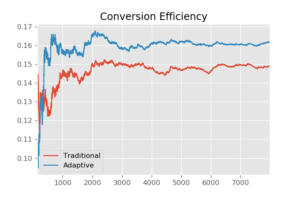Online Marketing: Using Reinforcement Learning for AB Testing
For any online website, a common way to decide on how to best market a product or feature is to do AB Testing.
What is AB Testing? Let us say a company interested in marketing a new product. So the marketing department sets up two webpages, A and B, each with a different marketing pitch. Then webpage A is presented to 50% of the potential customers visiting the website and webpage B is presented to the remaining 50% over a month or so. Afterwards, the data collected is analyzed. The one which has the highest conversion rate (as in visit resulting in sales) is adopted going forward.
This is a reasonably good approach. It is data driven and has been adopted in the past by Google, Amazon and many large companies.
However, there are some drawbacks. Let’s say that webpage A has a conversion rate of 10% while B has a conversion rate of 20%. If the company presents both A and B equally to potential customers over a month, the average conversion rate is 15%.
Can we do better? Most certainly. By employing reinforcement learning, our analytics can learn as data is streaming in and adaptively re-direct potential customers as it sees fit. This results in a higher average conversion rate. As is shown in the graph below, over time, this could translate into a 10% increase in sales compared to the traditional approach.

If we leave the adaptive analytics in place, if the conversion probabilities for webpage A and B should reverse in the future, the analytics will also learn and shift its behavior accordingly. That’s the beauty of reinforcement learning.
Contact us to set up an exploratory chat and discover how we can help you.
